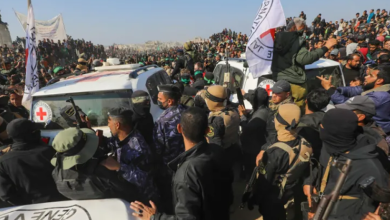Japan in ‘race against time’ to rescue flood victims


Japan’s Prime Minister Shinzo Abe warned Sunday of a “race against time” to rescue flood victims as authorities issued new alerts over record rains that have killed at least 48 people.
The torrential downpours have caused flash flooding and landslides across central and western parts of the country, prompting evacuation orders for more than two million people.
“Rescues, saving lives and evacuations are a race against time,” Abe said as he met with a government crisis cell set up to respond to the disaster.
“There are still many people whose safety has yet to be confirmed,” he added.
Top government spokesman Yoshihide Suga said the death toll after days of extreme weather now stood at 48, but this is expected to rise further, with local media saying more than 60 people were dead and dozens of others missing.

The rain has completely blanketed some villages, forcing desperate residents to take shelter on their rooftops with flood water swirling below as they wait for rescue.
Over two million people have been told to evacuate, but the orders are not mandatory and many remained at home, becoming trapped by rapidly rising water or sudden landslides.
The meteorological agency issued its highest level alert for two new regions on Sunday, while lifting the warnings for other areas where rains were subsiding.
Roads turned into rivers
In the town of Mihara, in the south of the Hiroshima region, a let-up in rain laid bare the devastation wrought by the downpours.
Roads were transformed into muddy flowing rivers, with dirt piled up on either side as flood water gushed around the wheels of stranded cars.
“The area became an ocean,” said 82-year-old Nobue Kakumoto, a long-time resident. “I’m worried because I have no idea how long it will stay like this.”
Several dozen residents descended into the village to inspect the damage after spending the night in a tiny shelter on higher ground.
Masanori Hiramoto, a 68-year-old farmer, didn’t bother observing the Japanese custom of removing his shoes when he entered his ravaged home, the woven tatami mat floors carpeted with mud.
“I don’t even know where to start cleaning. I don’t know what is where,” he told AFP.
Elsewhere, work crews tried to clear multiple small landslides that coated roads, rendering them virtually impassable.

“We are carrying out rescue operations around the clock,” Yoshihide Fujitani, a disaster management official in Hiroshima prefecture, told AFP.
“We are also looking after evacuees and restoring lifeline infrastructure like water and gas,” he added. “We are doing our best.”
In western Okayama prefecture, rescue operations were underway to evacuate several hundred people including children and elderly people from a hospital, including by helicopter.
Those in the building became trapped when a nearby river burst its banks and flooded the area, and a nurse inside told local media there was no power or water, and food was running short.
“Around 1,000 people were seeking rescue by Sunday morning, but we don’t yet have a complete picture of the disaster, which is enormous,” Mutsunari Imawaka, a spokesman for the prefecture’s disaster management office, told AFP.
“We are working hard to rescue them as quickly as possible. Time is running out. ”
Homes washed away
Over 50,000 rescue workers, police and military personnel have been mobilized to respond to the disaster, which has left entire villages submerged by flooding, with just the top of traffic lights visible above the rising waters.

“I was in a car and massive floods of water gushed towards me from the front and back and then engulfed the road. I was just able to escape, but I was terrified,” 62-year-old Yuzo Hori told the Mainichi Shimbun daily in Hiroshima on Saturday.
Though the rains began last week when a typhoon made landfall, the worst downpours hit from Thursday, when a construction worker was swept away by floodwaters in western Japan.
The toll has risen steadily since then, and the conditions have made rescue operations difficult, with some desperate citizens taking to Twitter to call for help.
The floods have halted production at plants across the affected region, with reports of electricity, water and mobile phone network outages.
The disaster is the deadliest rain-related crisis in Japan since 2014, when at least 74 people were killed in landslides caused by torrential downpours in the Hiroshima region.
(Source: AFP)




